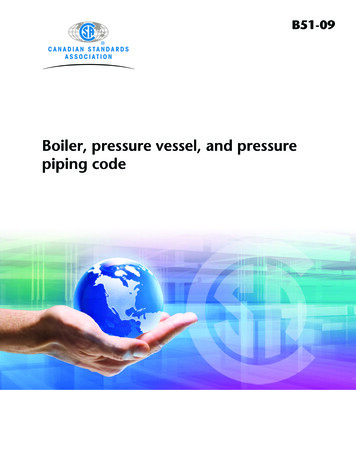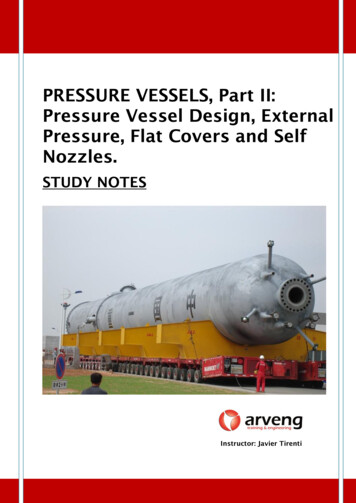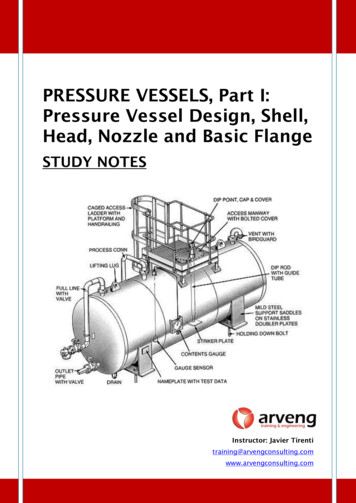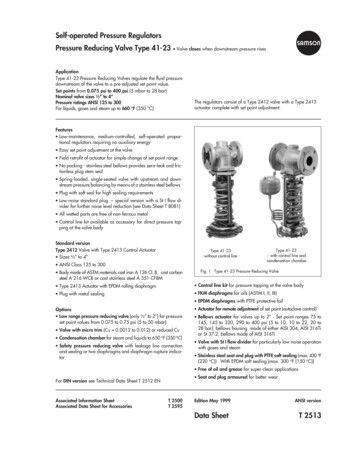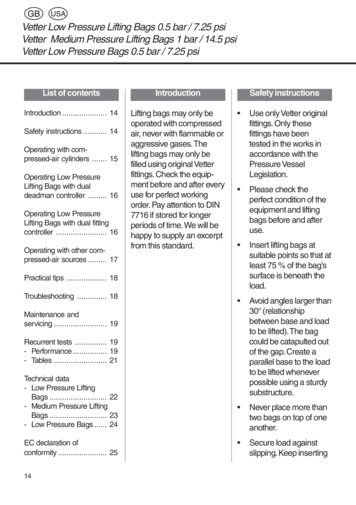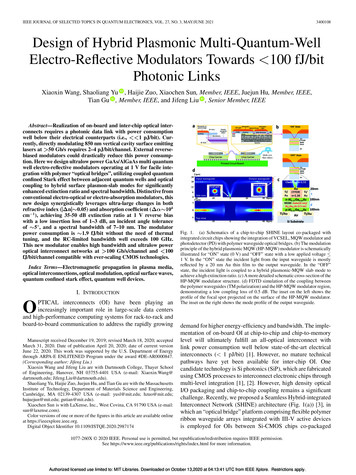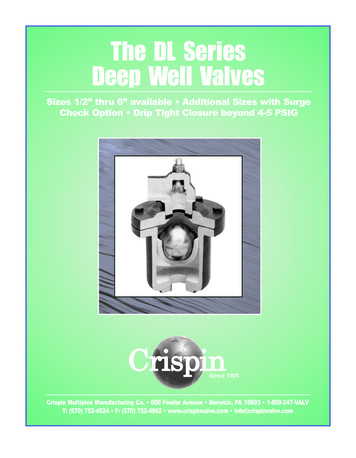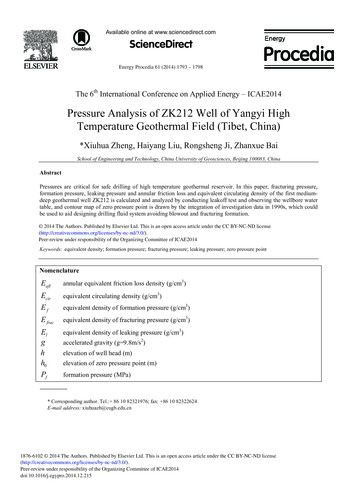
Transcription
Available online at www.sciencedirect.comScienceDirectEnergy Procedia 61 (2014) 1793 – 1798The 6th International Conference on Applied Energy – ICAE2014Pressure Analysis of ZK212 Well of Yangyi HighTemperature Geothermal Field (Tibet, China)*Xiuhua Zheng, Haiyang Liu, Rongsheng Ji, Zhanxue BaiSchool of Engineering and Technology, China University of Geosciences, Beijing 100083, ChinaAbstractPressures are critical for safe drilling of high temperature geothermal reservoir. In this paper, fracturing pressure,formation pressure, leaking pressure and annular friction loss and equivalent circulating density of the first mediumdeep geothermal well ZK212 is calculated and analyzed by conducting leakoff test and observing the wellbore watertable, and contour map of zero pressure point is drawn by the integration of investigation data in 1990s, which couldbe used to aid designing drilling fluid system avoiding blowout and fracturing formation. Publishedby ElsevierLtd. Thisis an open access article under the CC BY-NC-ND license 20142014TheTheAuthors.Authors.Publishedby y-nc-nd/3.0/).Selection and/or peer-review under responsibility of ICAEPeer-review under responsibility of the Organizing Committee of ICAE2014Keywords: equivalent density; formation pressure; fracturing pressure; leaking pressure; zero pressure pointNomenclatureEaflannular equivalent friction loss density (g/cm3)EcirEfequivalent circulating density (g/cm3)equivalent density of formation pressure (g/cm3)E fracequivalent density of fracturing pressure (g/cm3)Elghh0Pfequivalent density of leaking pressure (g/cm3)accelerated gravity (g 9.8m/s2)elevation of well head (m)elevation of zero pressure point (m)formation pressure (MPa)* Corresponding author. Tel.: 86 10 82321976; fax: 86 10 82322624E-mail address: xiuhuazh@cugb.edu.cn1876-6102 2014 The Authors. Published by Elsevier Ltd. This is an open access article under the CC BY-NC-ND nd/3.0/).Peer-review under responsibility of the Organizing Committee of ICAE2014doi:10.1016/j.egypro.2014.12.215
1794Xiuhua Zheng et al. / Energy Procedia 61 (2014) 1793 – 1798PlPfracfracturing pressure (MPa)Pppumping pressure (MPa)Tyz'hUffluid temperature (䉝)elevation of calculating depth (m)depth of calculating borehole point (m)over height of zero pressure point (m)fluid density in wellbore (g/cm3)leaking pressure (MPa)Subscriptsaaverage valueccold water1.IntroductionYangyi Geothermal Field, which located in the southern part of the Nagqu-Ngemo geothermal[1], [2]active belt and 45km southwest of Yangbajing and 75km west of Lhasa, is one of the high-temperatureconvective hydrothermal geothermal systems with lithologic character[3], [4]of mainly granite and andesitein Tibet. Pressure analysis to determine fracturing pressure and formation pressure is critical and helpfulto design drilling fluid system and its rheological and hydraulic properties, with which safe drilling ofhigh temperature wells could be achieved avoiding blow out or lost circulation.2.Tests and ObservationsPumping pressureˈMPa2.1. Leakoff test to determine fracturing pressureLeakoff test was conducted at the depth of 1154m[5] -[7]. The data of the pumping pressure was recordedevery 1 minute at the same time (Figure 1), in which point A infers leakoff beginning and point B infersformation fractured.6543210B: PpB 5MPaA: PpA 4MPadensity of pumping cold water ʌfc is 0.992 g/cm3 attemperature Tc of 40ć0246Time, min81012Fig. 1. Pumping Pressure Changes with Time during Leakoff Test
1795Xiuhua Zheng et al. / Energy Procedia 61 (2014) 1793 – 17982.2. Leakoff observationLeakoff observation during circulating was taken at the depth of about 467m and 1154m. Parameters ofleakoff rate, average temperature and density of drilling fluid were recorded and analyzed, with whichannular equivalent friction loss density and equivalent circulating density were calculated[8]-[11]. Theresults are shown in Table 1.Table 1. Leakoff Observation and Calculation of Equivalent DensityU f , g/cmEafl , g/cm3Ecir , 0.5361.53212310.9950.5271.522z ,mLeakoff Rate, f drilling fluid, ć3Elevation of Water Tableof ZK212ˈm2.3. Formation pressure testAfter drilling was completed 20 hours, elevation of water table of ZK212 in wellbore with the totalwell depth of 1510m was tested with metal wires and a multimeter (Fig.2).469246884684well depth 1510mh 4700mTa 140ćh0 Fig. 2. Elevation of Water Table of ZK2123.Results and Discussion3.1. Leaking and fracturing pressures of ZK212According to Figure 1 and Bourgoyne[6],PlPfrac103 Pl1.346 g / cm3gz103 Pfrac1.434 g / cm3PpB 10 3 U fc gz 16.22 MPa ˈ E fracgzPpA 10 3 U fc gz15.22 MPa ˈ El(1)(2)
1796Xiuhua Zheng et al. / Energy Procedia 61 (2014) 1793 – 1798From these results, it could be deduced thatPl and Pfrac of ZK212 are relatively low, indicating theprobability of leakoff and formation fracturing during drilling procedure. This is proved by the leakoffduring drilling operation. Table 1 shows leakoff rate is related to the properties of drilling fluid whichdetermines the equivalent circulating density.3.2. Formation pressure of ZK212According to Figure 2 and Wang[12], Pf could be calculated byPf10 3 g ( U fa 'h U fa (h y ))When PfEf0 , then yU fa h0(3)h 'h , and the point of h0 is called zero pressure point.U fa 'hU faz1.02 0.04 u 10 2 T 0.02 u 10 4 T 2Ef0.9248 (4)0.924(5)10.977z(6)Formula (6) indicates that E f of ZK212 decreases with the well depth and smaller than 0.9248, whichmeans it could be drilled with cold water without kick and blowout.3.3. Contour map of zero pressure point of Yangyi High Temperature Geothermal FieldIntegrated of ZK212 and Liang[1], elevation distribution of zero pressure points is calculated in Table 2and drawn as Figure 3, which illustrate that some wells might kick or blow out while some might leak offdepending on the value of 'h , which further suggests that some wells could be drilled with cold freshwater, and some should be drilled with brine or weighting drilling fluids to balance the formation pressure.This matches the observations on fields. Over height of zero pressure point 'h of a well could bededuced by contour map of zero pressure point of Yangyi Geothermal Field when its well head elevationis located.Table 2. Pressure Characteristics of Wells on Yangyi High Temperature Geothermal FieldWell No.h,mh0 , m'h , mT 000.940.881ZK2504719.614719.610189.930.870.980U fa ,g/cm3Ef, g/cm3
Xiuhua Zheng et al. / Energy Procedia 61 (2014) 1793 – 1798Fig. 3. Contour Map of Zero Pressure Points of Yangyi High Temperature Geothermal Field4.ConclusionAccording to the results discussed above some conclusions are drawn as follows:(1)ZK212 is of rather low E frac and El and is prone to leak off or fracture during drilling.(2) E f of a well of Yangyi Geothermal Field is related to its relative elevation of well head and zeropressure point, which means drilling fluids with different density should be designed to balance itsformation pressure.(3)Over height of zero pressure point 'h of a well could be deduced by contour map of zero pressurepoint of Yangyi Geothermal Field when its well head elevation is located.AcknowledgementsThis research is supported by “National Geothermal Resource Investigation” project of ChinaGeological Survey Bureau. Code:1212011120064References1797
1798Xiuhua Zheng et al. / Energy Procedia 61 (2014) 1793 – 1798[1] Liang T, Tan, Zhang D. Survey Report of Yangyi Geothermal Field in Dangxiong. Tibet. Lhasa: Bureau of Geology andMineral Resources of Tibet; 1992.[2] Lu R, An Y, Liang T. Development Program of Yangyi Geothermal Field in Tibet. Proceedings of Development andUtilization of High Temperature Geothermal Resources in Tibet of China; 1992.[3] Wang Y, Guo Q. The Yangbajing Geothermal Field and the Yangyi Geothermal Field: two representative fields of Tibet inChina. Proceedings World Geothermal Congress. Bali. Indonesia; 2010.[4] Qin C. Geothermal Geology in Tibet. Field trip guide T388 for the 30th International Geological Congress. China.Geological Publ. House; 1996.[5] Wessling S. Pressure Analysis of the Hydromechanical Fracture Behaviour in Stimulated Tight Sedimentary GeothermalReservoirs. Geothermics. 2009; 38:211-226.[6] Bourgoyne AT. Applied Drilling Engineering. Society of Petroleum Engineering; 1986.[7] Gao D. Drilling Technology of Deep and Ultradeep Wells under Complex Geology. China. Petroleum Industry Press; 2004.[8] Lapeyrouse NJ. Formulas and Calculations for Drilling. Production and Workover. 2nd ed. USA. Gulf ProfessionalPublishing; 2002.[9] Liu G. Diamond Drilling Manual.1st ed. China. Geological Publ. House; 1991.[10] SY/T 6613-2005. Recommended Practice on the Rheology and Hydraulics of Oil-Well Drilling Fluids. Industrial Standardof Oil and Gas of P.R. China; 2005.[11] Zheng X, Ye H, Bai Z. Balanced-Drilling and its Application on the Drilling ZK212 High Temperature Geothermal Wellof Yangyi in Tibet. Investitaion and Development of High Temperature Geothermal of China. Geological Publ. House; 2013.[12] Wang Z, Zhou S, Tang S. Pressure Gradient of Geothermal Fields and Yangbajing. Exploration Engineering. 1980; 02:7-8.A BRIEF BIOGRAPHY ABOUT THE AUTHORS Xiuhua Zheng, born in 1965, China university of geosciences (Beijing), professor, Dr. Geological engineering. Long engaged indrilling fluid technology and geothermal exploration and development of teaching and research work.Haiyang Liu, born in 1988, China universty of geosciences (Beijing), postgraduated student, major in geological engineering,specializing in geothermal exploration and development.Zhanxue Bai, born in 1986, China universty of geosciences (Beijing), postgraduated student, major in geological engineering,specializing in drilling engineering.
annular equivalent friction loss density and equivalent circulating density were calculated[8]-[11]. The results are shown in Table 1. Table 1. Leakoff Observation and Calculation of Equivalent Density z, m Leakoff Rate, m 3/h T a of drilling fluid, U f, g/cm3 E afl, g/cm 3 E cir, g/cm 466-467 20.344 20 0.998 0.234 1.232 467-468 6.552 33 0.994 0.189 1.183 1154-1157 28.5 28 0.996 0.536 1.532 .
